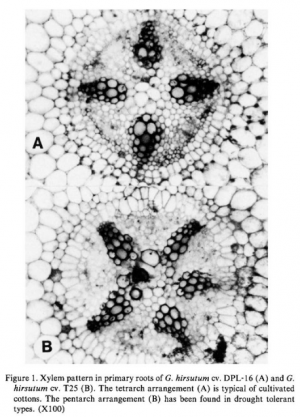When I started this, the fascination was about how I could find an X-word for my A to Z on agriculture. I took time and searched around a bit and the appendix of my trusty Cotton Physiology Handbook showed me this wouldn’t be too hard. But I have to admit, I don’t use xylem in everyday ag conversations.
What is a xylem?
Plants have vascular systems just like people, but for plants, rather than moving blood through arteries and veins, plants (like my beloved cotton) move water, nutrients and energy. The xylem is the part of the system that pulls water and nutrients up. So with that, let me step back a little bit.
Understanding Plant Vascular Systems
A leaf’s vascular system diagram from Dr. Mike Farabee, Estrella Mountain Community CollegeThe primary components of the vascular system of plants are really the way to transport critical pieces around in a plant. so the vascular system on sprouts would be really small and the vascular system of a sequoia would be big. These systems are designed to transport nutrients, water, and sugars around the plant. The website Biology4Kids.com has a great page (yes, I like the simple language it has compared to my cotton bible. Sorry if that disappoints) called Plants: Xylem and Phloem where the vascular system is described as:
It all starts with a top and a bottom. Logically, it makes sense. Trees and other vascular plants have a top and a bottom. The top has a trunk, branches, leaves, or needles. The bottom is a system of roots. Each needs the other to survive. The roots hold the plant steady and grab moisture and nutrients from the soil. The top is in the light, conducting photosynthesis and helping the plant reproduce. You have to connect the two parts. That’s where xylem and phloem come in.
The Xylem Provides the Supply of Water & Minerals
The roots of a plant are what help the plant reach water and nutrients. They help absorb the critical components for nourishment. As that stuff gets into the plant, the xylem takes over. The Biology4kids page says:
The xylem of a plant is the system of tubes and transport cells that circulates water and dissolved minerals. As a plant, you have roots to help you absorb water. If your leaves need water and they are 100 feet above the ground, it is time to put the xylem into action! Xylem is made of vessels that are connected end to end for the maximum speed to move water around. They also have a secondary function of support. When someone cuts an old tree down, they reveal a set of rings. Those rings are the remains of old xylem tissue, one ring for every year the tree was alive.
I wish I could find some old photos I took when I was in the field with one of the company’s soybean breeders because the photos showed a disease that shut down the vascular system, basically starving the plant. No they were awesome pics, but they came to mind. LOL.
Phloem Moves Sugars/Energy
Phytosynthesis is a process we all learned about in grade school. It’s the way plants convert sunshine into energy. Again, Biology4Kids basic explanation of phloem makes this understandable.
Most plants have green leaves, where the photosynthesis happens. When those sugars are made, they need to be given to every cell in the plant for energy. Enter phloem. The phloem cells are laid out end-to-end throughout the entire plant, transporting the sugars and other molecules created by the plant. Phloem is always alive. Xylem tissue dies after one year and then develops anew (rings in the tree trunk). What is the best way to think about phloem? Think about sap coming out of a tree. That dripping sap usually comes from the phloem.
Two to Go! Y and Z are for?
There are just two letters left on in my A to Z on agriculture! So what will Y and Z be for? Have you seen the other 23 letters? You can see the other posts in this series by clicking on the logo at right and reviewing the letters, or by browsing the A to Z ag tag archives. Yes, we are in the final days of April so I’m chugging along on the alphabet train! Got ideas for me?





Feels like college all over again! My basic take away from four years of plant, animal, and human biology is that pretty much everything is controlled by things moving from a high concentration of something to a low concentration. You know on a super basic level. 🙂
Glad I could help you relive your glory days! 🙂
Xylem! Last year we did an informal study in a floriculture class to determine the best floral preservatives. We compared 10 different solutions that have been touted as useful including using vodka, viagra, aspirin, vinegar, Listerine, 7-Up/Bleach, commercial preservatives, distilled water, tap water with a preservative dip and regular tap water. We found that the commercial preservative (stuff included in those little packets that come with bouquets) and the 7-Up/Bleach/water solutions worked the best. The commercial preservative has a biocide included to prevent bacterial growth from clogging the xylem and the homemade solution’s bleach provides the same effect. The commercial preservative also provides some sugars which is provided through the use of 7-Up. Moral of the story: when dealing with fresh cut flowers the xylem is all important to making them last! (Also always give a fresh cut when you get flowers!)
That’s useful information! Thanks for sharing.